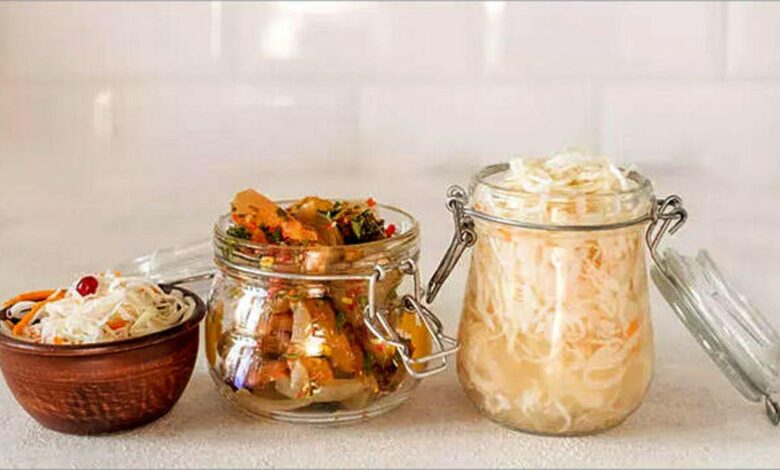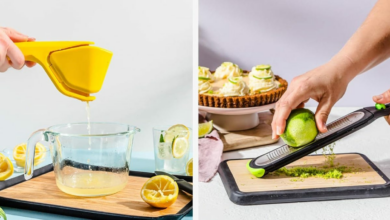12 probiotic foods to add to your diet for a healthy and happy gut

If you want a healthy gut, you need a healthy microbiome, the system of microbes that live in your intestines. You can use probiotic supplements to keep your microbiome in balance, or you can save some money and get probiotics from the foods you already eat.
“Probiotics are live microorganisms, often called ‘good bacteria,’ that help maintain a healthy balance in your gut by promoting the growth of beneficial bacteria and suppressing harmful bacteria,” says Gillean Barkyoumbregistered dietitian and nutritionist Plexus worldwide (which sells nutritional supplements).
“Probiotics are commonly found in fermented foods such as yogurt, kefir and sauerkraut, as well as in nutritional supplements,” she adds. “Consuming probiotics regularly can support digestion, strengthen your immune system, and even improve mood and overall well-being.”
Ultimately, probiotics contribute to your digestive health, which in turn can reduce depression, improve mental health, promote heart health, strengthen your immune system, and give your skin a healthy glow. Good intestinal bacteria can also help promote a healthy metabolism, which can reduce the risks of conditions such as obesity and diabetes. If you want to improve your gut health naturally, always consult your doctor first.
What are the best probiotic foods to eat for a healthy gut?
If you want more probiotics in your diet, below are 12 excellent probiotic foods. In addition to these foods, you can also try probiotic supplements. Look for labels that say “contains live cultures” or “contains active cultures” in these common probiotic foods.
1. Yogurt
An important probiotic food, choose yogurt with live and active cultures. Some yogurts are marketed specifically for their probiotic content or to help improve digestion. Yogurt usually has that L. acidophilus bacteriawhich can promote the growth of good bacteria in your intestines. Yogurt is a great option because it is widely available, comes in a variety of flavors to suit your tastes, and can be eaten straight from the package.
2. Kimchi
Kimchi is a traditional Korean side dish made by fermenting vegetables with probiotic lactic acid bacteria. Kimchi can give you that probiotic punch, and it’s made with healthy ingredients like vegetables (usually Chinese cabbage, carrots, scallions and radishes), garlic, red pepper powder, ginger and other spices. It is a delicious side dish and is traditionally served with steamed rice. Kimchi is associated with research about anti-cancer, anti-obesity, colorectal health, cholesterol reduction, anti-aging, brain health, immune health and skin health properties.
3. Pickles
You might be surprised to hear that pickles may contain probiotics. You just need to make sure you buy fermented pickles, which are usually found in the refrigerated section of the health food aisle. Some brands even advertise probiotic content. They trend under the term “healthy pickles,” but make sure you read the labels to make sure they contain probiotics. You can even make them at home. Some people also drink or use the juice in which the pickles have been fermented. Keep in mind that jarred pickles are often high in sodium.
4. Sourdough
Sourdough starter contains lactic acid bacteria. The starter is the environment where yeast and good bacteria grow by consuming water and flour. Natural prebiotics and probiotics are listed in research as one of the advantages of sourdough bread. It is also linked to better blood glucose control, reduced cholesterol, lower risk of diabetes, reduced risk of cardiovascular disease and improved weight management. It also makes a pretty good sandwich bread.
5. Kefir
Kefir is a fermented milk made using kefir grains. It starts out as regular cow or goat milk, and then a grain-like yeast and lactic acid bacteria colony called kefir is added to the milk. The mixture is left to ferment for about a day and then the milk is filtered from the grains, creating the kefir drink. The resulting drink is a powerful probiotic which actually contains more probiotics than yogurt.
6. Kombucha
Kombucha is “a favorite for fermented botanicals,” says Barkyoumb. “This magic potion is also called the ‘immortal health elixir’ for its ability to support the health and well-being of the entire body and prevent disease. High-quality kombucha is filled with probiotics and amino acids that help your body digest sugar, and is also a great natural hangover remedy.”
This drink is actually a fermented tea, so you get the health benefits of tea with the probiotic boost of a fermented drink. It’s made by adding bacterial strains, yeast, and sugar to black or green tea, leading to the drink’s probiotic-happy environment. It ferments for about a week or more until a mushroom-like texture grows on top. The mushroom is filtered out to make new kombucha.
7. Sauerkraut
This German comfort food is fermented cabbage, made by lacto-fermenting the vegetable in brine with salt. As part of the traditional fermentation process, probiotics are on the rise the final product.
However, this is another product that requires you to specifically purchase probiotic sauerkraut or make it yourself. Many brands use vinegar and sugar or are pasteurized, which reduces bacteria growth and kills probiotics. Regular canned sauerkraut is usually made with vinegar or pasteurized (or both).
8. Miso soup
This Japanese dish is served with many meals. Miso is a paste typically made from fermented soybeans and works as a seasoning for making sauces, spreads and soup stocks. Miso soup uses this paste for the broth. Because miso is a fermented food, it is packaged the probiotic punch. Miso soup works well with larger meals, but is also a tasty, light lunch on its own.
9. Apple cider vinegar
Apple cider vinegar is twice fermented apple juice. Apple cider vinegar has been making the rounds for years as a popular health supplement. It contains natural probiotics from the fermentation process. Although its benefits further research neededMany people also use it for everything from calming acid reflux to weight loss. It has a strong flavor, so if you don’t want to use it right away, add it to salad dressing, marinades, or pickling liquid.
10. Some cheese
Certain types of cheese contain probiotics. For example, aged cheeses that are not heated then tend to have probiotics. Examples include Swiss, Gouda, Cheddar, Edam, Gruyère, cottage cheese and provolone. The good news is that many popular cheeses contain probiotics, including a healthy bowl of cottage cheese topped with fruit.
11. Pickled vegetables
Along the same lines as the kimchi and pickles above, you can also look for pickled vegetables that specifically state that they contain probiotics. One idea is to look into lactic acid-fermented escabeche, a pickled dish from Mexico that can contain a wide variety of vegetables. Or you can make a fermented giardiniera, an Italian pickle sauce. Using fermented pickled vegetables is also a great way to shop local and preserve vegetables for off-season use.
12. Buttermilk
Buttermilk may seem like a drink from “Little House on the Prairie,” but traditional buttermilk can be an excellent source of probiotics. Buttermilk includes several types of fermented dairy drinks, but traditional buttermilk is the liquid extracted from the butter-making process. The trick is to avoid cultured buttermilk, which is the most common type in grocery stores and usually does not contain probiotics.




